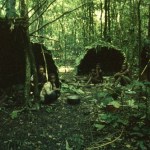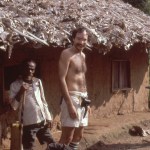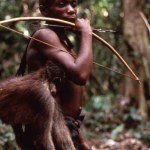Congo
Continuing with the theme of eating insects ...
The people of the eastern Congo plant African rice around June so that it will grow through the wettest part of the wet season, and then they harvest it in the "dry season" which starts about mid or late November. That is around the same time that a "locust" (actually a katydid of some sort) emerges in the grasslands to the north, in the Central African Republican and the Sudan, to spread across the region. And eat rice.
It is rather annoying to have locust descend on your crops. Some years it is not too bad, some years it is bad enough to…
Speaking of people eating insects ... as we were ... I do have this fun story from the Ituri Forest.
One day something funny happened. I was traveling in the most remote part of Central Africa, several days walk from any place you could possibly drive a car, visiting uncharted villages mainly occupied by people who had moved into the deep forest because they were in trouble with the "law" in some way (usually for perfectly good reasons in this lawless country). I was traveling with a Lese Villager and his sister, who was hired as our cook, and three Efe Pygmy men. We visited a village that…
I have written before of insects in the Ituri Forest. (Oh, and here too.) When it comes up that I've spent time there, certain questions often come up, and one of them is: "Did you eat bugs."
Every one has seen those National Geographic specials where some natives somewhere are eating insects, and of course, Westerners who think they generally don't eat insects are fascinated with the idea. Of course, Westerners eat a lot more insects than they think. You should really consider any processed food you eat that started out as a plant crop to be part insect. If what you are eating is made…
that has wandered into their camp if they don't know anything about it a priori is ... according to what they told me when that happened once ... is ...
Many, though certainly not all, insects are linked to important things in life. This is true of many things that are not insects as well. For instance, one does not walk to the right of a young male Canarium tree in the afternoon, because he who shall not be named could be sitting in the tree, and then you're screwed. Or, one should not handle the fetus of an antelope if any females in your family are planning on getting pregnant soon…
It has been said that our most distant primate ancestors, the mammal that gave rise to early primates but itself wasn't quite a primate, was most like the Asian tree shrew, which is neither a shrew nor does it live in trees. This is, of course, untrue. When the average American sees a shrew native to the new world scurrying past, he or she usually thinks of it as a form of mouse. Which it isn't. (In fact, there are no "mice" native to the new world, but even if we give our hypothetical observer the concept of "rodent" as in "eeek, a rodent" the shrew is not that either.) If you spend any…
An Efe forest camp is usually dark and depending on the time of day, dripping from current or recent rain. The Efe live in dome shaped huts which may be more or less complete. A half dome might be a hut that was built quickly, or it might be a hut that was built more openly because it has been hot or it might be only a half dome to allow easier access in and out of the hut by children or individuals with injury or infirmity. A fully domed hut, with a small opening, keeps in more smoke (a fire is often kept in the hut) but it also keeps in the heat and keeps out the rain. So a rainy…
When I first arrived in the Ituri Forest I was shown a camp a group of Efe Pygmies all typically lived in, and told "everyone lives here but the old man and his wife ... he's a bit contentious and there was an argument." Having read all the literature written in English about Pygmies, I was aware of the fact that these foraging people, who moved frequently -- perhaps ten times a year or more -- would often change the composition of their residence groups to reflect forming and breaking alliances among people who often, but not always, lived together. After hanging out in the camp, which was…
Thirty years ago yesterday, "the CDC's Morbidity and Mortality Weekly Report (MMR) published a report of five young men with Pneumocystis carinii pneumonia who were treated at three different hospitals in Los Angeles, California." (see This Blog Post for details). Morbidity and Mortality Weekly is a really fun journal to read. It contains the latest reports of, well, death and serious illness as a means of disseminating information in a way that will allow quick response. So, if there are suddenly a bunch of cases of some disease scattered across the country, this kind of reporting may…
On of my favorite books is A Bend in the River by V. S. Naipaul. It is a story set in at the junction of a native and expat community in an African rain forest country with a not very despotic leader (the "Big Man") at a time when a civil war was about to arrive on the scene. I like the book because of the writing, because of the story, because one of the character is supposedly based on someone I vaguely know (that's always fun) and because I was there .... living at the juncture of an expat and native community in a rain forested African country with a not-to-despotic leader named Mobutu…
Once you've killed the monkey, you need to carry it back to camp. Slit the tail, near the end, and poke the head through the slit, so the tail makes a handy strap.
Here's a detail:
An Efe (Pygmy) man making poison arrows for use in killing monkeys.
Ituri Forest, Zaire. Photograph Copyrighted 1986 Greg Laden
The arrows are thin darts of wood, often made of palm. Large marantacae leaves serve as a bowl and as a ladle. The poison includes a large number of ingredients, and the specific recipes vary a great deal (and are often guarded). This concoction included the juice pounded from a vine that contains strychnine. About seven arrows are fired at a monkey, up in the trees, per strike (on average) and it takes about two strikes to bring down a monkey. Several dozen…
It is probably true that every culture has child safety devices. It is also probably true that all of these devices are very limited in their effectiveness.
As an anthropologist living with the Efe Pygmies of the Ituri Forest, I often found myself observing some thing ... an object, a construction of some type, or a behavior ... that utterly baffled me. I learned to avoid asking about things as questions occurred to me; The very asking of a question, especially if you are roughly the equivalent of an alien visitor (an extraordinarily wealthy giant scary white being with highly advanced…
Nazi Holocaust: 1939 - 1945
War crimes trials: Fall 1945
DR Congo genocide: 1996-1997
War crimes trials: Still thinking about it.
I guess that brackets the range of potential variation.
(Note: This does not refer to the other, related genocide of Tutsi, for which trials have taken place.)
The old man crouched slightly as he took small tiny steps forward towards the woman's ass. I didn't see what was in is raised right hand, it was hidden from my view by his body draped with a colorful sarong. He crept closer, still crouched and still silent. She didn't see him coming, but when he finally struck the woman hardly seemed to notice. His hand, it turn out, bore what looked like a hand broom of the type used to sweep the dirt floors of the mud huts and open barazas, but smaller, cleaner, and cut somewhat differently. He used it to strike a fly off her bottom and when the surprised…
The UN's human rights chief has said the "scale and viciousness" of mass rapes in DR Congo "defy belief", as a report into the attack was released.
Navi Pillay said that, even for the region, the incident stood out because of the "extraordinarily cold-blooded and systematic way" it was carried out.
Some 300 people were raped by armed militia in the attack in August.
Details here
In which I explore the interface between the Jungian Subconscious and my own primordial anguish.
The blocked end tube pipe is a touchstone to the shamanistic world of the people we call the Hopewell. Similar artifacts are found elsewhere in the world, but the Adena-Hopewell cultural complex (dating to approximately a thousand year plus long period centering on "Zero" AD/BC/b.c.e.) has more of them than your average archaeological culture. The blocked end tube is made of soapstone, and is a cylinder almost hollowed out but with a wall of stone left intact so nothing physical can actually…
We were standing behind my friend Andre's store in Isiro, Zaire, waiting for Andre to finish receiving some orders so we could sit down for some tea, or may be some beer, and do a little black market trading.
A big truck with a canvas top stretched over an iron frame was backing up to the loading dock. These loading docks had solid concrete bases set at the approximate height of a freight truck's bed, and with a large concrete and steel canopy over the top to provide shade and protection from the rain. All this concrete and steal is normal for the region: Most houses are made of either…
Up to 140 people are feared dead after a boat carrying passengers and goods capsized on a river in the Democratic Republic of Congo, officials say.
The accident happened on the Kasai river - a tributary of the Congo River - in the western province of Bandundu.
Information Minister Lambert Mende told the BBC the boat had been overloaded and 80 people had been confirmed dead.
After decades of conflict, DR Congo has few roads or rail links and many people travel on often overloaded vessels.
I've not been on this boat, but I've been on one like it. It is true that you can't actually drive from,…
In the part of suburban New Jersey I grew up in, almost every other school took the cougar for its sports team mascot. There were the Carl H. Kumpf Middle School Cougars, the Cranford High School Cougars, and the Kean University Cougars, among others. Nevermind that cougars were extirpated from the state long ago - they were a top choice as symbols of the agility, cunning, and ferocity sports teams like to believe they channel. The use of such totems extends beyond sports. Exxon tells us we can "put a tiger in the tank" by using their fuel, and many people adorn themselves with clothing or…
A leading rights activist in the Democratic Republic of Congo has been found dead in the capital, Kinshasa.
Floribert Chebeya's body was discovered, partially clothed, on the back seat of his own car.
source
He was last known to have gone to a meeting with the national chief of police, Genral John Numbi. His driver has disappeared.
Amnesty International's deputy Africa director, Veronique Aubert, issued a statement upon hearing of his death: "We are stunned and appalled by the suspicious death of such a prominent and respected human rights defender".
source



